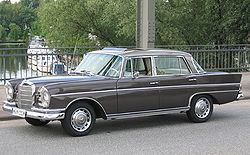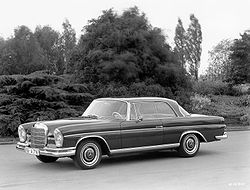- Mercedes-Benz W112
-
Mercedes-Benz W112 

Manufacturer Mercedes-Benz Also called 300SE / 300SE long Production 1961—1965 (4-door)
1962—1967 (2-door)Assembly Stuttgart Untertürkheim, Germany Predecessor Mercedes-Benz W189 (4-door)
Mercedes-Benz W188 (2-door)Successor Mercedes-Benz W109 (4-door)
Mercedes-Benz W111 (280SE 3.5, 2-door)Class Full-size Luxury car Body style 4-door sedan
2-door coupe
2-door convertibleLayout FR layout Engine 3000 cc M189 I6 Related Mercedes-Benz W111
Mercedes-Benz W113- See Mercedes-Benz S-Class for a complete overview of all S-Class models.
The Mercedes-Benz W112 (also known as the 300SE) was a flagship model in Mercedes-Benz's line-up during the early 1960s. The car, produced in four modifications: coupé, cabriolet and sedans, was identical to the standard Mercedes-Benz W111 Fintail car, but was fitted with the M189 big-block six-cylinder engine, as well as more luxurious features such as air suspension, power steering, automatic transmission, more expensive wood and leather trim details, etc.
Contents
Description
To fully understand the significance of the W112, it is important to understand, that prior previous generation of vehicles consisted of entry-level 4-cylinder 180/190 series, mid-range 220 series of sedan, coupe and cabriolet, a sports 190SL coupe and roadster, all built on a unified Ponton unibody chassis. Topping them was the exquisite 300 series of sedan, coupe, cabriolet and roadster, hand-built on the increasingly archaic X-frame chassis based on pre-war models. This construction was compensated with luxurious features and a price tag, that made these vehicles available only to elite of royal pedigree. In addition there was the 300SL coupe/roadster, built on a unique tubular platform.
In the late 1950s, Daimler began to initiate a new policy economy of scale, and decided to unify its luxury and standard range in the next generation of cars. Already in 1957, assembly of all 2-door 300S W187s stopped, in 1958 the fuel-injected W128 220SE Ponton arrived, and from 1959 the Mercedes-Benz showcased its new generation of fintail models. First came the 220/220S/200SE W111 sedans, these were joined in 1961 by the 220SE W111 coupe and cabriolet and the four cylinder W110 190 and 190D. However a replacement for the big W189 Type 300 Adenauer limousine, was still being drawn-up. So, Mercedes-Benz decided to break its previous taboo and placed the big six-cylinder 3-litre engine from the W189 into a W111. This was a big gamble, as many 300 customers would not see kindly their exquisite vehicles replaced by an ordinary car, but the sales of the W112 showed the opposite.
Mercedes-Benz took a large set of measures in terms of marketing to separate the W112 from the W111. This included separate brochures, the cars were presented in different showrooms. Externally the cars were adorned with almost double the chrome details that were available to the W111s, bigger 14" rims and features such as power steering, pneumatic suspension and automatic transmission as standard (though manual would return as an option). The car cost almost double the value of the top range 220SE W111. In 1963 Mercedes-Benz went on to create the long-wheelbase sedan, commonly, though incorrectly, referred to as the 300SEL (Mercedes-Benz would introduce the L suffix in the next generation). Performance-wise the 300SEs topped the range, with the M189 bix-six engine producing 160 hp (170 after 1964) and giving a top speed of 180 km/h (190 after 1964, both figures 175 and 185 for automatic transmission respectively).
The W112 turned out to be a very short-lived venture. In 1963 Mercedes-Benz premièred the true replacement for the Adenauer, in the new W100 600 limousine. Having filled its top niche, demand for the W112 plummeted and production volume fell drastically: if in 1962 2.769 such cars were built, the next year this fell to 1.382, and in 1965 with the coming of the W108/109 series the sedan W112 went into history, with a total of 6.748 300SEs in standard and long wheelbase. The rarity of the car is further punctuated by the fact that in 1962 for every W112 sedan there was 24 W111s rolling off the production line, and by 1964 this ratio was almost 1:40.
The Coupe and cabriolet 2-door W112s fared better. Arriving in 1962, only a year later after the première of the 2-door W111s. The latter was offered as a single 220SE model and thus the 300SE served as its the only stable mate. Hence a 5:1 production ratio was kept. The two-door W111/W112 was production continued after 1965 with the coming of the new generation W108/W109 sedans. However in 1967, Mercedes-Benz chose to finish producing the now-ancient M189 engine, by this point, it had finished its planned changes in car classes and there was no point in continuing to market a separate car chassis number. Replacement arrived in face of the 280SE which took its place on the production line, though the true successor as a flagship model can be the V8 powered 280SE 3.5 which arrived in 1969 and was built until 1971.
Although its short production run, the W112, allowed Mercedes-Benz to tie together its top range vehicles with its mid-range series. In doing so, it ended the previous nomenclature of 190/220/300, and allowed a common practice of exchanging engines between one chassis and another. The LWB 300SE became another milestone, and long wheelbase models became standard in all future S-Class generations. The 300SE sedan was also very successful in international and European Touring Car Championship and won several rallys.
Despite using the same number, the W112 has no relation to the 1991 Mercedes-Benz C112 experimental mid-engined sportscar.
Models
- 1961–1965 300 SE Sedan (5,202 built)[1]
- 1962–1967 300 SE Coupé (2,419 built)
- 1962–1967 300 SE Cabriolet (Convertible) (708 built)
- 1963–1965 300 SE long long-wheelbase Sedan (1,546 built, often wrongly called 300 SEL)
Model timeline
Chassis Type 1961 1962 1963 1964 1965 1966 1967 W112 sedan 300SE 300SE long coupé 300SE cabriolet (convertible) 300SE See also
References
- "Mercedes-Benz U.S Models". Hiwaay.net. Archived from the original on November 25, 2005. http://web.archive.org/web/20051125151608/http://home.hiwaay.net/~gbf/mbmodels.html. Retrieved December 1, 2005.
External links
« previous — Mercedes-Benz road car timeline, 1946–1970s — next » Class Type 1940s 1950s 1960s 1970s 6 7 8 9 0 1 2 3 4 5 6 7 8 9 0 1 2 3 4 5 6 7 8 9 0 1 2 3 4 5 6 7 8 9 4-cylinder Sedan W136 / W191 W120 / W121 W110 W115 W123 Roadster R121 6-cylinder Sedan W187 W105 / W180 / W128 W111 W114 W123 Coupé W187 W180 / W128 W111 C107 Large car Sedan W111 W108 / W109 W116 Coupe W188 W112 Limousine W186 / W189 W100 (600) Sports Roadster W198 W113 R107 Coupé W196S Categories:- Mercedes-Benz model codes
- Vehicles introduced in 1961
Wikimedia Foundation. 2010.
